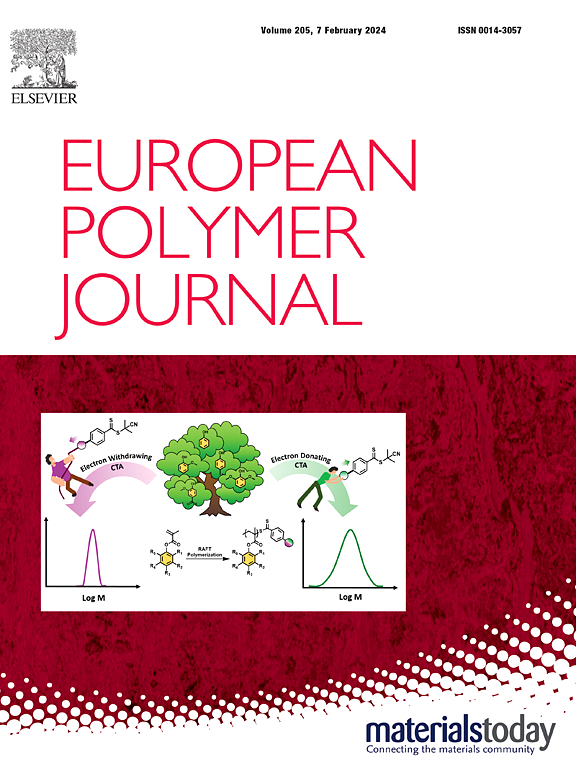Synthesis, characterization, and application of biodegradable superabsorbent gels based on carboxymethyl chitosan-modified sodium lignosulfonate
IF 5.8
2区 化学
Q1 POLYMER SCIENCE
引用次数: 0
Abstract
In this study, a novel three-dimensional bio-based superabsorbent hydrogel, SL-P(AA-AMPS)/CMCS, was synthesized via freeze-drying using sodium lignosulfonate (SL) with rigid phenylpropane structures as the bio-based framework, carboxymethyl chitosan (CMCS) enriched with hydrophilic groups (–OH, –COOH, and –NH2) as the hydrophilic modifier, and acrylic acid (AA) and 2-acrylamido-2-methylpropanesulfonic acid (AMPS) as monomers. Polymerization was initiated by ammonium persulfate (AP) and crosslinked with N,N’-methylenebisacrylamide (MB). The hydrogel’s structure, morphology, and absorption properties were systematically characterized using Fourier transform infrared spectroscopy (FT-IR), X-ray diffraction (XRD), X-ray photoelectron spectroscopy (XPS), and scanning electron microscopy (SEM). Results revealed a uniform porous structure with an average pore size of 5.8 μm. Absorption capacities in deionized water and 0.9 % NaCl solution reached 1132.9 g/g and 127.9 g/g, respectively, surpassing commercial diaper fillers (273.3 g/g and 61.5 g/g) and feminine hygiene products (223.5 g/g and 45.8 g/g). Under pressurized conditions (2068 Pa), absorption values remained high at 125.7 g/g (deionized water) and 24.0 g/g (0.9 % NaCl solution). The hydrogel exhibited exceptional water retention, retaining 88.8 % and 85.8 % of absorbed water after 8 h at 40 °C and 60 °C, respectively. Swelling kinetics followed a pseudo-first-order model (R2 > 0.99), achieving equilibrium within 600 s (deionized water) and 60 s (0.9 % NaCl solution). Biodegradation tests demonstrated a 47.5 % degradation rate in soil after 28 days, significantly exceeding that of non-bio-based P(AA-AMPS) (3.7 %). Application tests highlighted superior absorption capacities for artificial urine (82.4 g/g) and blood (179.2 g/g), outperforming conventional hydrogels by 3.3- and 7-fold, respectively.

羧甲基壳聚糖修饰木质素磺酸钠可生物降解高吸水性凝胶的合成、表征及应用
以刚性苯丙烷结构的木质素磺酸钠(SL)为生物基骨架,富含亲水性基团(-OH、-COOH和-NH2)的羧甲基壳聚糖(CMCS)为亲水性改性剂,丙烯酸(AA)和2-丙烯酰胺-2-甲基丙烷磺酸(AMPS)为单体,通过冷冻干燥法制备了新型三维生物基高吸水性水凝胶SL- p (AA-AMPS)/CMCS。聚合反应由过硫酸铵(AP)引发,并与N,N ' -亚甲基双丙烯酰胺(MB)交联。利用傅里叶变换红外光谱(FT-IR)、x射线衍射(XRD)、x射线光电子能谱(XPS)和扫描电子显微镜(SEM)对水凝胶的结构、形貌和吸收性能进行了系统表征。结果表明,该材料具有均匀的孔隙结构,平均孔径为5.8 μm。在去离子水和0.9% NaCl溶液中的吸收量分别达到1132.9 g/g和127.9 g/g,超过了市产纸尿裤填料(273.3 g/g和61.5 g/g)和女性卫生用品(223.5 g/g和45.8 g/g)。在加压条件下(2068 Pa),吸附值保持在125.7 g/g(去离子水)和24.0 g/g (0.9% NaCl溶液)。水凝胶表现出优异的保水性,在40℃和60℃作用8 h后,水凝胶的保水率分别为88.8%和85.8%。膨胀动力学遵循伪一阶模型(R2 >;0.99),在600秒(去离子水)和60秒(0.9% NaCl溶液)内达到平衡。生物降解试验表明,28天后土壤降解率为47.5%,显著超过非生物基P(AA-AMPS)的3.7%。应用试验突出了对人工尿液(82.4 g/g)和血液(179.2 g/g)的优越吸收能力,分别比传统水凝胶高出3.3倍和7倍。
本文章由计算机程序翻译,如有差异,请以英文原文为准。
求助全文
约1分钟内获得全文
求助全文
来源期刊

European Polymer Journal
化学-高分子科学
CiteScore
9.90
自引率
10.00%
发文量
691
审稿时长
23 days
期刊介绍:
European Polymer Journal is dedicated to publishing work on fundamental and applied polymer chemistry and macromolecular materials. The journal covers all aspects of polymer synthesis, including polymerization mechanisms and chemical functional transformations, with a focus on novel polymers and the relationships between molecular structure and polymer properties. In addition, we welcome submissions on bio-based or renewable polymers, stimuli-responsive systems and polymer bio-hybrids. European Polymer Journal also publishes research on the biomedical application of polymers, including drug delivery and regenerative medicine. The main scope is covered but not limited to the following core research areas:
Polymer synthesis and functionalization
• Novel synthetic routes for polymerization, functional modification, controlled/living polymerization and precision polymers.
Stimuli-responsive polymers
• Including shape memory and self-healing polymers.
Supramolecular polymers and self-assembly
• Molecular recognition and higher order polymer structures.
Renewable and sustainable polymers
• Bio-based, biodegradable and anti-microbial polymers and polymeric bio-nanocomposites.
Polymers at interfaces and surfaces
• Chemistry and engineering of surfaces with biological relevance, including patterning, antifouling polymers and polymers for membrane applications.
Biomedical applications and nanomedicine
• Polymers for regenerative medicine, drug delivery molecular release and gene therapy
The scope of European Polymer Journal no longer includes Polymer Physics.
 求助内容:
求助内容: 应助结果提醒方式:
应助结果提醒方式:


